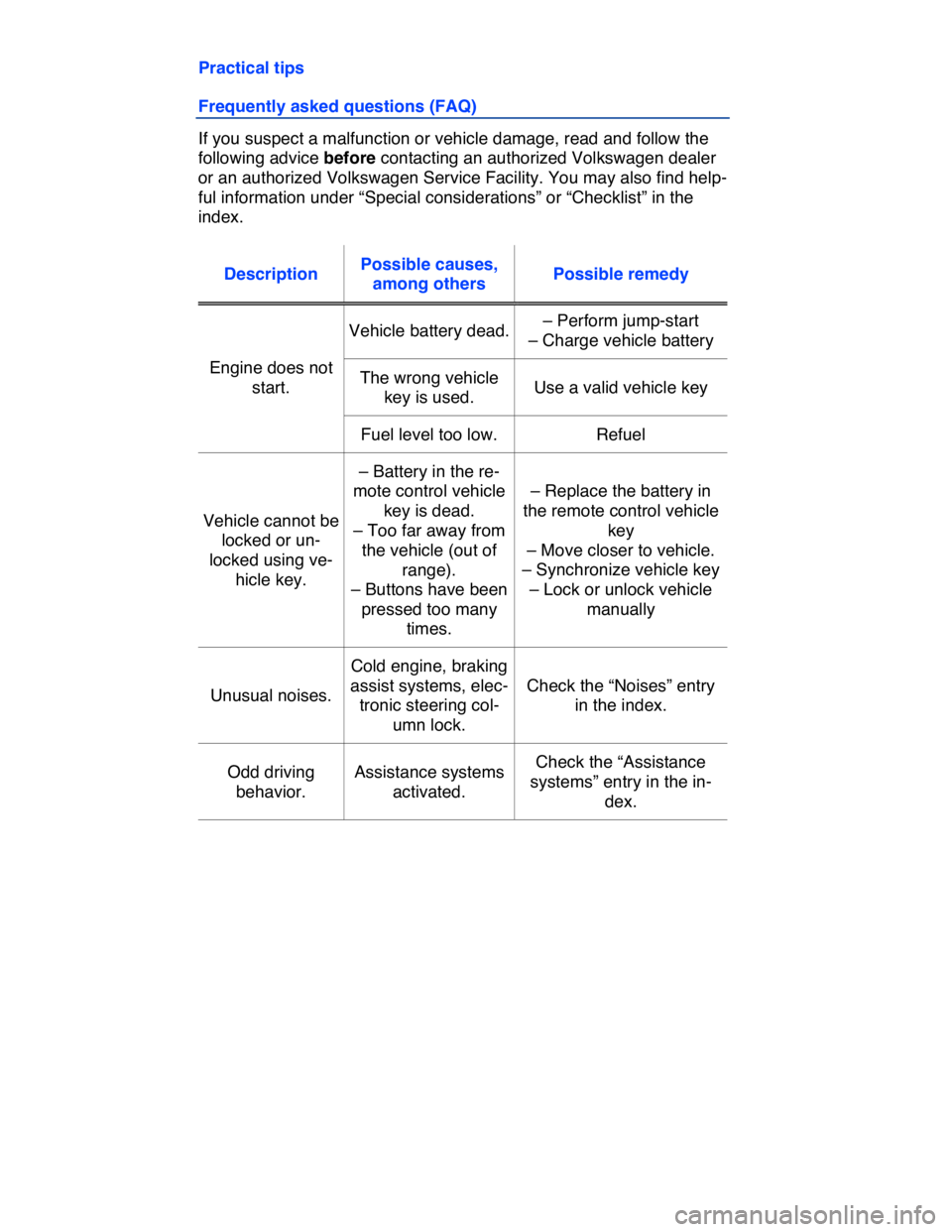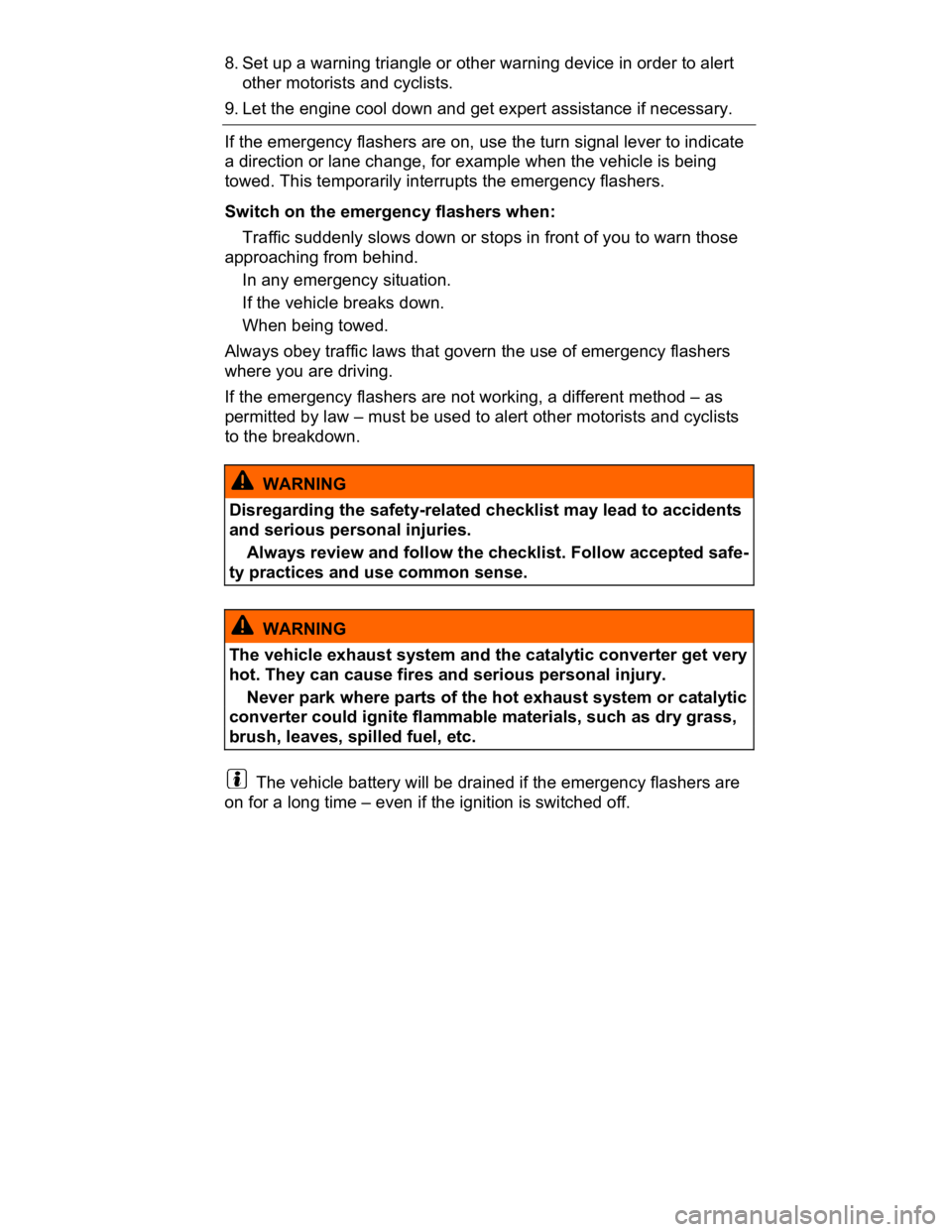Page 498 of 578

Practical tips
Frequently asked questions (FAQ)
If you suspect a malfunction or vehicle damage, read and follow the
following advice before contacting an authorized Volkswagen dealer
or an authorized Volkswagen Service Facility. You may also find help-
ful information under “Special considerations” or “Checklist” in the
index.
Description Possible causes,
among others Possible remedy
Engine does not
start.
Vehicle battery dead. – Perform jump-start
– Charge vehicle battery
The wrong vehicle
key is used. Use a valid vehicle key
Fuel level too low. Refuel
Vehicle cannot be
locked or un-
locked using ve-
hicle key.
– Battery in the re-
mote control vehicle
key is dead.
– Too far away from
the vehicle (out of
range).
– Buttons have been
pressed too many
times.
– Replace the battery in
the remote control vehicle
key
– Move closer to vehicle.
– Synchronize vehicle key
– Lock or unlock vehicle
manually
Unusual noises.
Cold engine, braking
assist systems, elec-
tronic steering col-
umn lock.
Check the “Noises” entry
in the index.
Odd driving
behavior.
Assistance systems
activated.
Check the “Assistance
systems” entry in the in-
dex.
Page 500 of 578
Description Possible causes,
among others Possible remedy
Electrical con-
sumers do not
work.
Vehicle battery
charge too low. Charge vehicle battery
Remaining fuel level
too low. Refuel
Fuse blown. Check fuse and replace if
necessary
Fuel consumption
higher than indi-
cated.
– Short hauls.
– “Jumpy” accelera-
tor pedal.
– Avoid short distance
driving.
– Drive defensively.
– Accelerate smoothly.
Electrical loads
switched on.
Switch off unnecessary
loads.
Engine control
malfunction.
Have the malfunction cor-
rected
Tire pressure too
low. Adjust tire pressure
Driving in the
mountains.
No direct corrective action
possible.
Towing a trailer or
driving with a roof
rack.
– Check use.
– Remove if not in use.
Driving with heavy
payload.
No direct corrective action
possible.
Driving at high en-
gine speed. Select a higher gear.
Page 505 of 578

8. Set up a warning triangle or other warning device in order to alert
other motorists and cyclists.
9. Let the engine cool down and get expert assistance if necessary.
If the emergency flashers are on, use the turn signal lever to indicate
a direction or lane change, for example when the vehicle is being
towed. This temporarily interrupts the emergency flashers.
Switch on the emergency flashers when:
� Traffic suddenly slows down or stops in front of you to warn those
approaching from behind.
� In any emergency situation.
� If the vehicle breaks down.
� When being towed.
Always obey traffic laws that govern the use of emergency flashers
where you are driving.
If the emergency flashers are not working, a different method – as
permitted by law – must be used to alert other motorists and cyclists
to the breakdown.
WARNING
Disregarding the safety-related checklist may lead to accidents
and serious personal injuries.
� Always review and follow the checklist. Follow accepted safe-
ty practices and use common sense.
WARNING
The vehicle exhaust system and the catalytic converter get very
hot. They can cause fires and serious personal injury.
� Never park where parts of the hot exhaust system or catalytic
converter could ignite flammable materials, such as dry grass,
brush, leaves, spilled fuel, etc.
The vehicle battery will be drained if the emergency flashers are
on for a long time – even if the ignition is switched off.
Page 560 of 578

WARNING
Improper use of jumper cables when jump-starting a vehicle
with a dead battery can cause the battery to explode, leading to
serious personal injury. To help reduce the risk of battery ex-
plosion:
� All work on the batteries or the electrical system in your ve-
hicle can cause serious acid burns, fires, or electrical shocks.
Always read and heed the following WARNINGS and safety pre-
cautions before working on the batteries or the electrical sys-
tem ⇒ Vehicle battery.
� Always make sure that the battery providing starting assis-
tance (the booster battery) has the same voltage as the dead
battery (12 V) and about the same amperage capacity (see bat-
tery label).
� Never jump-start a vehicle with a thawed or frozen vehicle
battery. The battery can explode. A dead battery can freeze at
temperatures around +32 °F (0 °C).
� A battery that is frozen or was frozen, but has since thawed,
must be replaced.
� When the vehicle battery is jump-started, it gives off hydro-
gen gas, which is highly explosive! Always keep fire, sparks,
open flame, and smoking materials far away from vehicle bat-
teries. Never use a mobile telephone while connecting or dis-
connecting jumper cables.
� Jump-start batteries only in well-ventilated areas. Batteries
give off highly explosive hydrogen gas during jump-starting.
� Always route the jumper cables so that they cannot get
caught in any moving parts in the engine compartment.
� Never short out the battery terminals by connecting the posi-
tive (+) and negative (-) terminals with each other.
� Never connect the negative cable from the other vehicle di-
rectly to the negative terminal of the dead battery, as this may
cause the hydrogen gas given off by the dead battery to ex-
plode.
� Never attach the negative cable from the vehicle providing
starting assistance to any part of the fuel system or to the
brake hoses or brake lines.
Page 565 of 578

WARNING
Improper use of jumper cables when jump-starting a vehicle
with a dead battery can cause the battery to explode, leading to
serious personal injury. To help reduce the risk of battery ex-
plosion:
� All work on the batteries or the electrical system in your ve-
hicle can cause serious acid burns, fires, or electrical shocks.
Always read and heed the following WARNINGS and safety pre-
cautions before working on the batteries or the electrical sys-
tem ⇒ Vehicle battery.
� Always wear proper eye protection. Never lean over the vehi-
cle battery.
� Attach the jumper cables in the correct order: first the posi-
tive cable, then the negative cable.
� Never connect the negative cable from the vehicle providing
starting assistance to parts of the fuel system or to the brake
hoses or brake lines.
� Never allow the non-insulated parts of the battery clamps to
touch.
� Never allow the jumper cable attached to the positive battery
terminal to contact metal parts of the vehicle.
� Check the battery acid level indicator window on the vehicle
battery. Use a flashlight, never a match, cigarette lighter, or
other open flame. If you cannot see the color of the window
clearly, or if it is light yellow or colorless, do not jump-start the
vehicle. Get expert assistance.
� Avoid electrostatic discharge in the vicinity of the vehicle
battery. Sparks may cause the hydrogen gas escaping from the
vehicle battery to ignite.
� Never jump-start a vehicle with a battery that is damaged or
frozen or that was frozen and has thawed. The battery can ex-
plode. Replace the battery instead.
� Always follow the instructions of the jumper cable manufac-
turer.
� Always make sure that the battery providing starting assis-
tance has the same voltage as the dead battery (12 V) and
about the same capacity (see battery label).
Page 569 of 578
� Unburned fuel can get into the catalytic converter during tow-
ing and damage it.
Towing on a commercial tow truck
�
Page 578 of 578
hp Horsepower – unit of measure for engine power
kg Kilogram – metric unit of measure for weight
kN Kilonewton – a unit of measure for force
kPa Kilopascal – unit of measure for tire pressure
kp Kilopond – unit of measure for force
kW Kilowatt – engine rating
LED Light Emitting Diode
m Meter – metric unit of measure for length
MDI Media Device Interface (MEDIA-IN)
MFI Multi-Function Indicator
Nm Newton meter – a unit of measure for engine torque
PDC Park Distance Control
RON Research Octane Number – measurement of anti-
knock resistance of gasoline
rpm Engine revolutions per minute (engine speed)
SAE Society of Automotive Engineers
TSI® Turbocharged gasoline engine with direct fuel injec-
tion
XDL Extension of the Electronic Differential Lock system
5S man 5-speed manual transmission
6S auto 6-speed automatic transmission
6S man 6-speed manual transmission